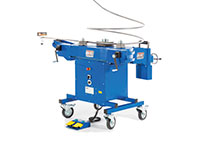Roll-bending is based on press bending
The bending tool (normally a segmental tool) with integral radius is pressed, either manually or hydraulically, against the workpiece, which is mutually fixed by two counter bearings. This movement forces the inserted tube to bend around the bending segment. With the 3-roll bending device, the pressing tool and the counter bearings are replaced by tool rolls. In addition to spot bending, the rolls can be put in rotation in order to achieve a rolled radius. The positioning of the rolls towards each other defines the radius, and the traverse path defines the bending angle. By engaging a lifting roll, optionally helices with a defined inclination can be manufactured. It is extremely challenging to manufacture this geometry true to size and this can only be achieved with the help of measuring devices and a tube calculation program. Since the tubes cannot be supported from inside during roll bending, this procedure is, without a loss in quality, only appropriate for thick-walled tubes or/and large bending radii.
Clear advantages of this bending system are:
- mobile horizontal bending machines
- large bending radii
- variable radius control – the smallest bending radius is initially defined on the machine
- variable applications for tubes and profiles
- Maintenance-free drives
- three phase motor
- variable bending speed
- by the 3-roll drive, high feed forces and very small radii in a bending operation





